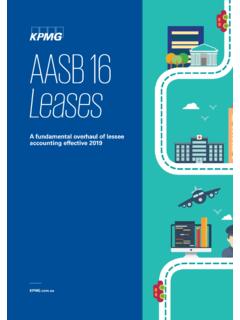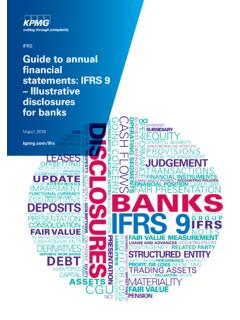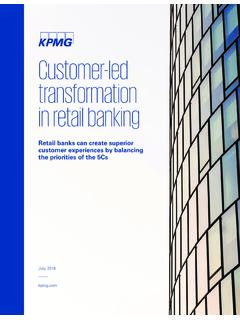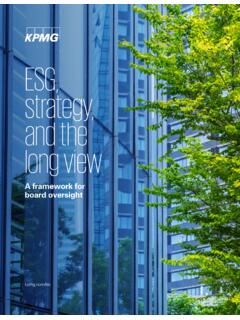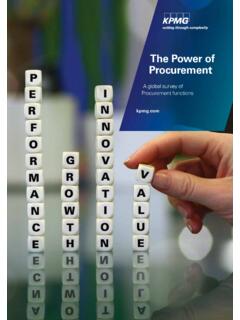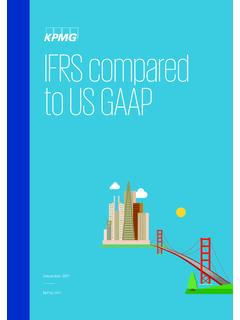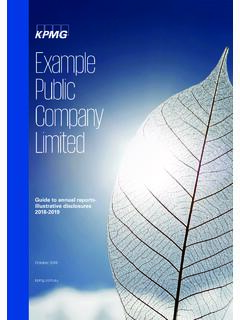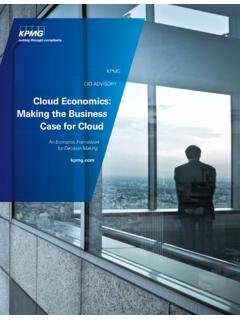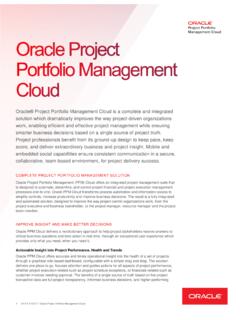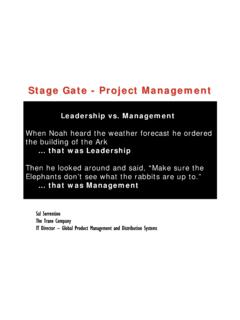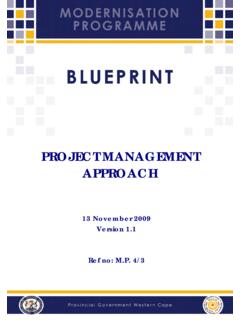Transcription of Project Risk Management - assets.kpmg
1 Project ADVISORYP roject Risk Management Leadership Series 9 the Leadership SeriesKPMG s Project Advisory Leadership Series is targeted towards owners of major capital programmes, but its content is applicable to all entities or stakeholders involved with major projects. The intent of the Project Leadership Series is to describe a framework for managing and controlling large capital projects based on the experience of our Project professionals. Together with our simplified framework, we offer a sound approach to answer the questions most frequently asked by Project risk managementProject risk Management is frequently overlooked yet is one of the more critical elements to successful Project delivery.
2 Generally, delivering a Project s defined scope on time and within budget are characteristics of Project success. Unfortunately, these success factors are often not achieved, especially for large complex projects where both external influences and internal Project requirements may change significantly over time. Project risk Management is a continuous process of identifying, analysing, prioritising and mitigating risks that threaten a projects likelihood of success in terms of cost, schedule, quality, safety and technical performance. Organisations and owners often consider Project risk Management activities as nice to have on a Project rather than as a core component of Project controls.
3 Additionally there is some confusion between organisations and Project teams as to what exactly constitutes risk Management activities. In this paper, we provide a standard framework for risk Management and discuss implementation techniques for projects of all types and sizes. This should provide you with a better understanding of how to address the following challenges: Do we have a comprehensive Project risk Management policy? What elements of Project risk Management are necessities for our organisation to implement? How do we balance the requirements and controls of a risk Management programme with efficient and streamlined Project execution?
4 Are our current Project risk Management procedures effective at mitigating Project risk? How do we align our Project specific risk Management activities with our enterprise risk Management objectives? What are some key questions we should be asking about Project risks throughout the Project lifecycle?Defining Project risk managementThe objective of Project risk Management is to understand Project and programme level risks, minimise the likelihood of negative events and maximise the likelihood of positive events on projects and programme outcomes. Project risk Management is a continuous process that begins during the planning phase and ends once the Project is successfully commissioned and turned over to owners, Project teams and contractors often define and apply risk Management activities differently on a Project .
5 Owners may use informal or ad hoc practices, such as stage gate approval, that they interpret as risk Management activities, contractors may define risk Management as tracking potential change orders, and Project teams may express the view that everything we do is risk Management . While all of these activities help to identify and manage discrete elements of Project risk, they do not fully describe a comprehensive approach to Project risk Management . A comprehensive Project risk Management approach should have the following components, which should be scalable to the specific Project s size and type:1.
6 Strategy and planning;2. Risk identification;3. Analysis (quantitative and qualitative);4. Response planning; and5. Monitoring and Strategy and planningStrategy and planning activities set the foundation for a risk Management programme and ultimately determine whether the initiative is successful. During the strategy and planning phase an organisation will define how risks are addressed and managed. Strategy and planning should take into consideration: Corporate or enterprise-wide risk Management guidelines (including tolerance level for risk); Available resources (staffing, budgets); Preferred reporting and communication protocols; and The organisation s strategic and planning activities include: Assigning roles and responsibilities related to risk Management activities; identifying and defining requirements for Project stakeholders regarding risk Management activities; Establishing common risk categories for identified risks.
7 Categories can wither be based on common industry risks or on the organisations risk categories ( construction, financial, operations, governance etc); and Developing a risk matrix and assigning risk ratings to identify risks. The risk matrix should define risk ratings based on probability and impact by taking into account the organisations risk Risk identificationRisk identification is the identification of all possible risks that could either negatively or positively affect the Project . It is important in the risk identification process to solicit input from all Project stakeholders including those outside of the core Project team.
8 Potential contributors to risk identification include: Project team members (planners, engineers, architects, contractors etc); Risk Management team members; Subject matter professionals (IT, Safety, Legal etc); Customers (internal and external); End users; and Organisation Management and capturing all Project risks increases with frequent communication and feedback amongst team members and stakeholders. These discussions should attempt to identify inaccuracies, inconsistencies and assumptions regarding the Project . The resulting product of these working sessions should be the initial list of identified the initial list of identified risks, a risk register or log can be populated to ensure that all risk items are analysed, prioritised and monitored.
9 Risk registers should typically include the following fields: Risk type; Description; Cost impact; Probability; Risk level; Possible responses; and Action AnalysisThe analysis phase determines the likelihood and impact of each identified risk and prioritises risks for Management attention. Successful risk analysis requires objective thinking and input from those most familiar with the area affected by the possible risk. Analysis is typically a two-step approach:Step 1 Qualitative analysisFor the qualitative analysis, the Project team assigns a priority level ( high, medium, low) to each risk.
10 The priority level should be aligned with the organisations risk Management plan, risk tolerance level and other organisational objectives. The priority levels can be used to rack the risks on the risk register and develop efficient response plans that focus attention on items with a higher priority. It is important to identify all potential risks that will require follow up by the Project 2 Quantitative analysisFor the quantitative analysis, the Project team assigns a most likely cost value to each identified risk. This value takes into consideration both the probability and potential impact of the risk event occurring.

